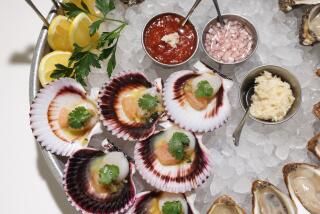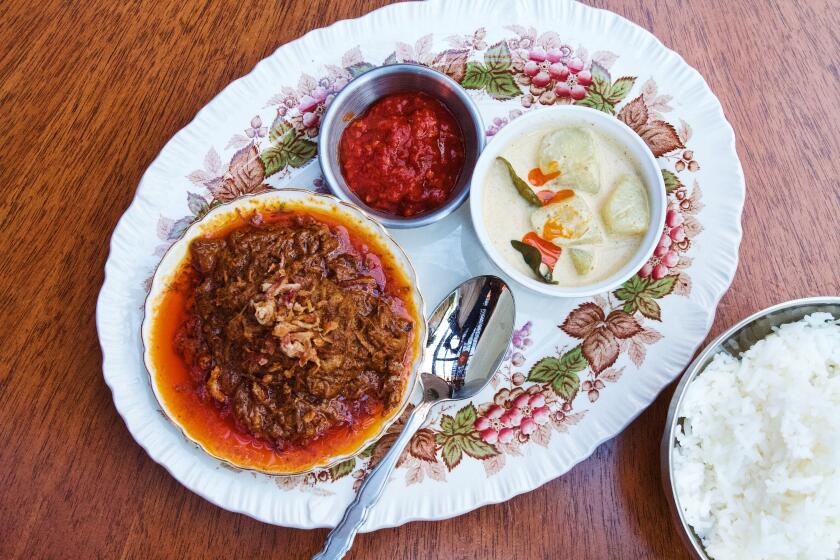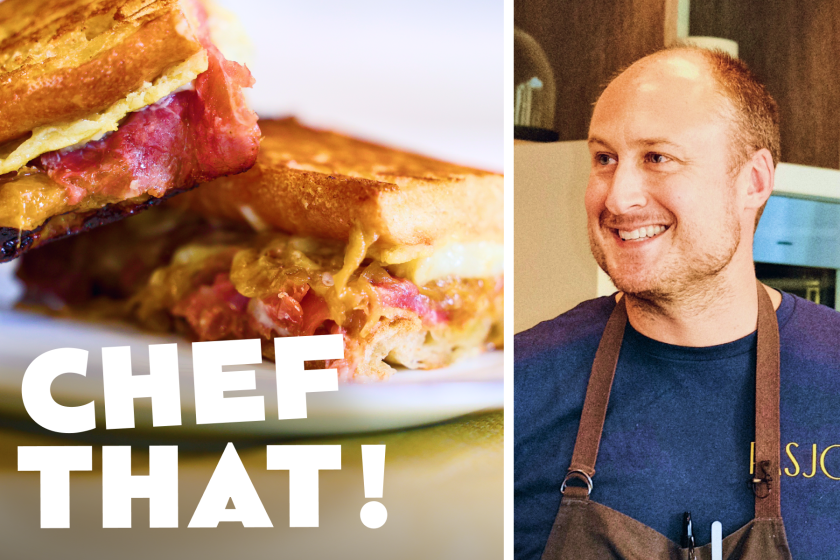Pantry Raid: A diet of good intentions
Most of us are too plump and are overly fond of snacks, fast food — and food in general. So why did two lean young women who dine on smoothies and organic fruits and vegetables (how unimpeachable does that sound) seek help cleaning up their act?
May Haduong, 33, and Frances Motiwalla, 34, just had this sense they were slaves to each passing fad (greens! organic! flaxseed! gluten-free!) and were building up their eating rules in a haphazard, unscientific way.
“We’ve sort of made it up in our heads,” Haduong says: whirring up slurries of kale, beet greens, frozen fruits and celery in the blender in their pint-sized kitchen twice a day (down to once a day when Motiwalla couldn’t take it anymore). Buying $55 cans of raw, vegan, organic sprouted-rice protein powder. Culturing (in Motiwalla’s case) kombucha, a type of fermented tea. And busting out (in Haduong’s case) for afternoon feeding frenzies on Crispix cereal.
“We kind of think it’s healthy,” Haduong says of the diet, “but is it really?”
Adds Motiwalla: “We’ve been doing the same thing over and over again, and it’s getting a little bit routine.”
Registered dietitian Lisa Gibson of Irvine visited the couple’s Echo Park home, sifted through contents of freezer, fridge and cupboards, and then talked with them about their habits and goals, which include saving money.
There was much Gibson liked about what Motiwalla and Haduong did. There were other things that bothered her. They weren’t getting enough nourishment, for one thing: “Most people don’t get enough green leafy vegetables — but they were actually getting too much of those and not enough of other nutrients,” she says.
Some of their measures were unnecessary, costing them cash for no real gain. And Gibson just felt they were cheating their taste buds.
Read on for the results of the Motiwalla-Haduong Pantry Raid — and, for contrast, go online to our collection of past columns to see very different kinds of dietary makeovers.
What the pair do right:
They don’t eat much fast and processed food. Their kitchen is loaded with frozen produce, steel-cut oatmeal, nuts. About the only processed items to be found in their freezer were Korean dumplings and gelato. (OK, Gibson can live with that.)
They don’t overeat: Both are slim. (They’ve lost about 5 pounds apiece, in fact, since they went on their smoothie regimen.)
They eat lots — lots! — of fruits and vegetables. (Gibson encourages them to make sure they sample a wide range.)
They put most of the rest of America to shame in these three ways.
What needs tweaking:
They’re not taking in enough calories — which may be why Haduong attacks the Crispix box in the afternoon. “Your body is saying, ‘I need more food,’” Gibson says.
They don’t exercise or eat much dairy. Since they’re thin and small-boned, they run the risk of developing osteoporosis. Gibson recommends that they ramp up some on milk, yogurt or cheese and start weight-bearing exercise (even something as simple as walking for half an hour a day) to save their skeletons.
Their diet is unnecessarily harsh: They’re subbing real meals for smoothies for no real good reason. “Part of food is enjoying the taste of it, liking to cook, and you’ve eliminated that part,” Gibson tells them. No need to cut out the smoothies altogether — they’re convenient, the couple like them better than eating greens in salad form — but why not diversify? They should also consider adding Greek yogurt to the smoothies to give them more protein and calories.
They need more protein — but they don’t need expensive protein powder. “Just eat real food,” Gibson says. An egg is a lot cheaper than the equivalent in powder and every bit as good. She also recommends cottage cheese, Greek yogurt, chicken and beans. The couple should be aiming for 5 to 6 ounces of protein spread out over the course of the day to provide steady fuel for their bodies and satisfy their hunger pangs.
Haduong avoids gluten. Does she need to, or has she latched on to the fad du jour? Gibson notes that only 1% of the population actually has celiac disease and maybe 4% to 5% more have a gluten intolerance. Cutting out gluten if you don’t have those problems makes for an overly restrictive diet. Haduong says she feels better and has less joint paint when she’s gluten-free, but Gibson encourages her to experiment with adding a whole wheat items back to her diet for the fiber and nutrients they contain.
They waste money. On protein powder, organic everything. “I think we’re so afraid of food, and there’s so much food misinformation,” Gibson says. If the couple is worried about pesticides, she suggests they save buying organic for the so-called “dirty dozen” — items such as apples, celery and strawberries that are most likely to contain pesticide residues. (See the whole list at https://www.ewg.org/foodnews). Still, Gibson says, “there’s been no long term research that shows that if you eat organic you’re going to live longer.”
They don’t cook much. What they do cook is good: When they rustle up one of their standard meals — organic chicken in a Maggi-based sauce; broccolini sautéed in garlic, salt and pepper; and organic brown rice — Gibson gives it an A+ for nutrition and declares it delicious. But they need to broaden their repertoire. For anyone in the same boat, Gibson recommends Cooking Light and epicurious.com for a vast array of healthful, easy-to-toss-together meals.
Before she leaves, she samples one of Motiwalla and Haduong’s smoothies. “Tasty,” she says. “But that chicken smells better.”
More to Read
Eat your way across L.A.
Get our weekly Tasting Notes newsletter for reviews, news and more.
You may occasionally receive promotional content from the Los Angeles Times.










